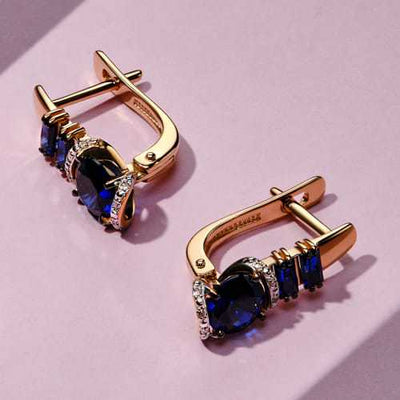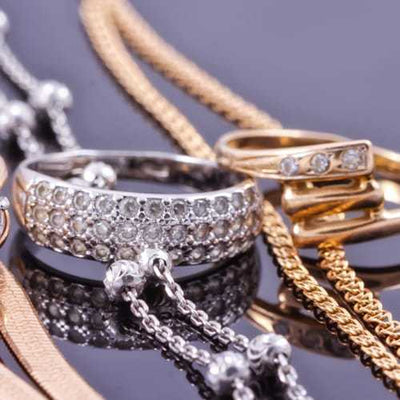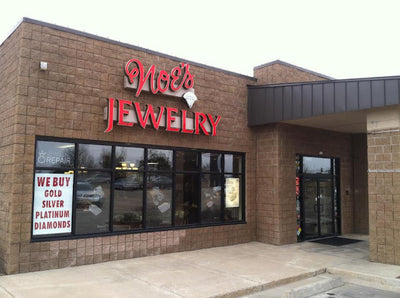The third article in our four-part series about the 4 C’s of diamonds is focused on the term “color.” The color of a diamond really refers to the lack of color. The less color the diamond has, the more desirable it becomes. Color is considered the second-most important characteristic to consider when purchasing a diamond. Colorless diamonds are highly valued, and diamonds with noticeable color often appear as a pale yellow.
Read the previous article in our series: diamond cut
How Does Color Grading Work?
Color evaluation is done on a D-to-Z grading scale. Diamonds given a D grade are considered to be colorless, while those with a Z grade are said to have a light color. To grade color in diamonds, a special environment must be created to eliminate color from surrounding surfaces and light sources. While minor differences in the color of diamonds can be determined in this special environment, it is very hard to see the difference between ad D, E, and F graded diamond in a normal environment. For this reason, many people are willing to get an E or F graded diamond to save a little money.
It is important to remember that all diamonds graded on this scale are considered white even though they may start to look more yellow. Color names are reserved only for fancy colored diamonds, which are intended to have color.
Here’s a quick breakdown of diamond color ratings:
- Colorless: Colorless diamonds are those given a D, E, or F grade. There are very slight differences between these three grades, but only an expert gemologist will be able to see these differences.
- Nearly Colorless: G, H, I, and J graded diamonds are considered nearly colorless. To the naked eye, these diamonds will look mostly colorless, but there will be tints of color. Diamonds with one of these grades are less rare than truly colorless diamonds. For diamonds in this grade, price tends to drop by 10 to 15 percent per grade without noticeable differences to the untrained eye.
- Faint Tint: Diamonds graded K, L, and M are said to have a faint tint. Even an untrained naked eye will be able to see a slight yellowish tint. These diamonds generally sell for half the price of those in the nearly colorless range.
- Very Light Tint: N-R graded diamonds are in the very light tint category. These diamonds have a noticeable yellow or brown tint, which puts them at a lower price point than all of the diamonds in the higher grades.
- Light Tint: Light tint is the term used to describe diamonds in the S to Z color range. These diamonds have a noticeable yellow or brown tint and are usually not recommended by jewelers.
Color Importance Based on Diamond Shape
Certain diamond shapes can hide color flaws better than others. This ability is due to the unique structure of certain diamond shapes. The arrangement of the diamond’s facets can also greatly impact the appearance of color for a diamond.
Here, we have rated the significance of color for each diamond shape on a scale of one to ten with one being the least important and ten being the most important:
- Round: 3
- Princess: 5
- Emerald and Asscher: 6
- Oval, Pear, Heart, and Marquise: 7
- Cushion and Radiant: 8
Pairing Different Graded Diamonds with Metals
Diamonds with D to F grades should only be set in white gold or platinum settings. If you set a colorless or nearly colorless diamond in yellow gold, the diamond will reflect the yellow color of the metal, which negates the colorless effect of the diamond.
If you want a yellow gold setting, you could go with a diamond that has a more yellowish tint. The trick is to make sure that the diamond looks white when compared to the yellow gold setting. J or K graded diamonds are a good option for a yellow gold, or even rose gold, setting.
Pairing Center Diamonds with Side Stones
When you are purchasing a ring or other piece of jewelry with numerous stones, you are going to need to think a little harder about the diamond color. Side or accent diamonds in an engagement ring or similar piece of jewelry need to either match the color grade of the center stone or be slightly darker than the center diamond to accent the higher color grade of the center stone.
With a solitaire engagement ring, this isn’t a consideration that you need to make, but you might want to think about using your budget in other areas other than color to avoid overspending on this feature.
What About Fancy Colored Diamonds?
Fancy colored diamonds are not diamonds that have been given a grade on this color scale. Instead, these diamonds, which range in color from yellow to blue to pink, are graded on a separate color scale, because they are meant to be colorful.
The rarest, and accordingly most valuable, colored diamonds are saturated pinks, greens, and blues. With colored diamonds, even very slight color differences can have a huge impact on the value of the stone.
Yellows and browns are the most common fancy colored diamonds. Even diamonds with only light hues of color, as long as they show color in the face-up position, will qualify as a fancy colored diamond. Red, green, and blue diamonds with a medium to dark tone and moderate saturations are very rare. It takes a highly specialized diamond grader to deal with the fancy color grading process.
The color range focuses on the strength and intensity of the colors of the diamonds. But not all colors offer the same range of color saturation. For example, yellow diamonds come in a wide range of saturation, but blue diamonds don’t.
Blue diamonds are considered extremely rare, and they usually have a tint of gray. They are usually less saturated than blue sapphires, which have the more desirable blue color that some customers seek in blue gems. The color of blue diamonds is caused by the presence of boron impurities, and the more boron present in the stone, the deeper the blue color of the diamond.
Green diamonds are usually light in tone with low saturation. Generally, these diamonds are yellowish-green or have a brownish or grayish cast. The hue of green diamonds is usually only found on the surface of the stone, so cutters try to leave as much natural rough around the girdle as possible. The color is caused by radiation displacing carbon atoms in the stone. These diamonds are also extremely rare.
Brown diamonds are the most popular of the fancy colored diamonds. These diamonds are often called “cognac” or “champagne” diamonds. Brown diamonds range from very light to very dark in tone. Brown diamonds in medium to dark tones with a warm golden or red appearance tend to be the most popular.
Yellow diamonds are also very popular, and they are often called “canary” diamonds. Black, white, and gray diamonds are also available.
The popularity of some of these colored diamonds is due to their attractiveness. For example, pure pink diamonds are more popular than those that are purplish, orangey, grayish, or brownish. Some of the pinker stones are placed in a “rose-colored” category, while purple-tinted diamonds are placed in a “mauve” category.
For colored diamonds, the color is the most important aspect of the 4 C’s. The others aren’t likely to affect the value of the stone nearly as much as the color in this case.
For more information on colored diamonds, check out GIA’s Colored Diamonds Color Reference Charts.
Visit Noe’s Jewelry in Raymore, Missouri, today to see a wide variety of diamonds in a variety of different color grades and fancy colors. Contact us today at 816-322-7227 for answers to any of your diamond color questions.
Part one of the 4 C’s series: carat weight
Part two of the 4 C’s series: diamond cut
Part three of the 4 C’s series: color
Part four of the 4 C’s series: diamond clarity






